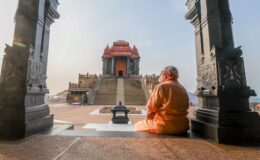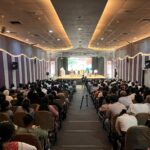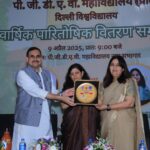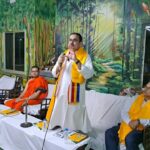The great bond of union
- By : Anirban Ganguly
- Category : Articles
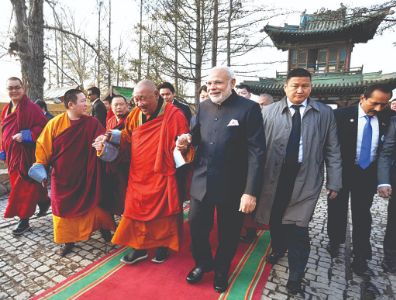
Third edition of Samvad will serve as a global platform to shape and influence the emerging neo-world order
The third edition of Samvad – Hindu-Buddhist initiative for conflict avoidance and environmental consciousness – is being held in Ulaan Bataar, capital of Mongolia – a region and civilisation that gives rise to images of valour, of spirituality and a deep connect with India of the yore.
An initiative of PM Modi and realised through the efforts of the New Delhi based Vivekananda International Foundation, over the years Samvad has emerged as one of the principal global Indic civilisational outreach platforms. It will see a convergence of scholars, thinkers, spiritual and religious masters, public intellectuals from across the world. They will gather to deliberate on the need for strengthening the Indic-Dharmic narrative and to discuss how to shape and influence, through the power of civilisational thought, philosophical wisdom and cultural outreach, the emerging neo-world order in which the Indic civilisational framework aspires to play an increasingly decisive role.
In Mongolia, the third edition of Samvad has struck a deep chord. Leaders, both political and religious, see it as a great confluence from which will emerge a refreshed civilisational partnership. Despite the many vicissitudes and challenges, Mongolians see Samvad as taking forward to the next step what PM Modi had initiated here in 2015. The Speaker of the Mongolian Parliament, the Prime Minister of Mongolia, most of the leading Buddhist monks led by the venerable Khamba Lama, head of the Gandan Monastery – the centre of Mongolian Buddhism – a most venerated figure in Mongolia, who is the co-host, are all going to be active participants in this congregation.
Why Mongolia, some have asked. The region which was once central to our Bharat has over the years receded in memory and is only now gravitating back towards centrality once more, especially after 2015 when PM Modi undertook a historic visit to the country and imparted a modern shape to our ancient connect. Iconic Kushak Bakula Rinpoche’s centenary year in 2018 and its fitting observance brought this region, its cultural and strategic importance to centre-stage once more. As I sit here next door to the branch of the Pethub Monastery in Ulaan Bataar, the thoughts of Rinpoche Bakula and his decade long tenure as India’s Ambassador in Mongolia, his great efforts in reinfusing a new vigour and energy to Buddhism in Mongolia come to mind. An unparalleled patriot – Rinpoche Bakula was unequivocal that Ladakh’s future and fate lie with India – he did more than anyone else to firmly re-establish Bharat’s presence in the region. In recent times, PM Modi rekindled that flame through his visit and outreach.
But again, why Mongolia, as some have averred, that question is perhaps best answered in the words of another intellectual giant, a polymath and civilisational scholar, the likes of which India has not seen in recent times. Dr Raghuvira continues to be a venerated name in this part of the world. In that difficult era of minimal physical connectivity, his series of outreach to Mongolia, his efforts to preserve Mongolian texts and to reconnect both our countries culturally remains unparalleled in the history of modern scholarship of both the countries.
Being an active politician – eighth president of the Bharatiya Jana Sangh – Dr Raghuvira never gave up on his quest for connecting and retracing India’s civilisational footprints. Why Mongolia thus is best answered in his words, “It is surprising to an extraordinary degree when one goes into the interior of Mongolia and finds a herdsman who is interested in the literary theories of Dandin’s Kavyadarsa or wants clarification of some point in Panini’s phonetics…One of the mountains in Mongolia is named Sumeru and another Vaidurya. A lake is named after Durga. Yamantaka, Mahakala, Yama and Kali are worshipped among all the Mongols. Goddess Tara is cherished by men, women and children…Stories of King Bhoja and Vikramaditya are prevalent under the name of Arji Burji, that is the form which has endeared itself to the tongues of the Mongols. Pronounced in our way, it will be Raja Bhoja. The small lyric of Kalidasa, Meghaduta has also found a place of honour in Mongolian literature; similarly, the stories of Panchatantra…”
The fundamental vision of Samvad is again perhaps best described in the words of Dr Raghuvira who had penned a piece titled, “We the Pilgrim Beings”, a good seven years before independence in 1947. Referring to countries and civilisations of southeast Asia, far east and Mongolia, he observed, how, “In spite of the difference in the political control of these countries inhabited by diverse people, Indian culture still remains as the great bond of union. Political boundaries have been changing for the last 2000 years, ever since, Indian culture spread to these countries. Different dynasties have ruled over them, sometimes they have been free and sometimes dependent. But Indian culture has come down as one continuous flow…The glory of India lies in the distribution of spiritual gifts…” The rediscovery of that “great bond of union” and to re-state and re-invent it for the present geostrategic, geo-cultural context is then the deeper aim and vision of Samvad.
Samvad evolved out of the vision of PM Modi. Over the years, ever since he became PM and has undertaken an extensive and unceasing world outreach at all levels, Modi has spoken of the twenty-first century as being the Asian century. He has defined and articulated a vision of the Asian century in which the civilisational southeast Asian collective, the contours of the Indo-Pacific and the shores and periphery of the Indian Ocean will play a major role. PM Modi has emphasised that in shaping and defining the Asian century, the wisdom and message of Buddha, the eternal and pragmatic truths of the Vedas and the roots of Dharmic thought will play a crucial role.
India, being the land of Buddha’s birth, being the land in which the Master propounded his philosophy, being the centre from which radiated his wisdom the world over for centuries, has a special role and responsibility to generate a synergy and make an united effort towards realising the hope and dream of an Asian century. India’s civilisational wisdom of environmental consciousness, its thought on governance and statecraft, its well-evolved and recorded positions on moralities and values in the polity and in human dealings are pointers which can help evolve a credible and enduring narrative of the Asian century. India has the capacity to blend the soft and the hard power, she has the ability to evolve a smart power matrix as well.
PM Modi has clearly seen and felt the need of re-stating these on the world stage, of giving these a modern context and idiom and of the need for India to retrace her civilisational footstep in the region. India’s footsteps and outreach continue to be looked upon as a benign touch, a touch that aspires to partner, to celebrate local diversities and uniqueness, that strives to strengthen bonds of partnership and camaraderie. A sense of hegemony, an imposed uniformity, a rough and violent approach is entirely absent in India’s outreach. PM Modi had commissioned a grand Buddha murti as well as the construction of the Battsagaan Grand Assembly Hall in the Gandan Monastery, both of which will be consecrated in the morning of September 6. In his vision, these new infusions will stand as symbols of a new beginning.
The golden Buddha murti, designed by the legendary sculptor Ram Sutaar, has been installed in the Grand Assembly Hall overlooking the mesmerising Bogd Khan mountain range that encircles Ulaan Bataar. It has a magical look, Buddha’s look of Karuna – compassion is piercing as well as engulfing. “This is a statue, a look, which the people of Mongolia have not seen in ages, it has generated a wave among the people here…”, an elderly monk whispered, when I stood to gaze at it. Samvad aims to kindle such emotions in its quest to realise the Asian Century.



